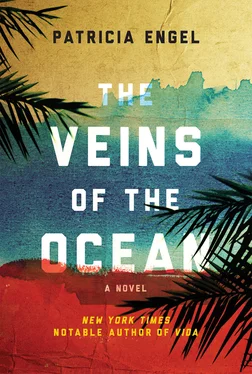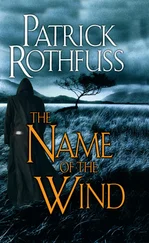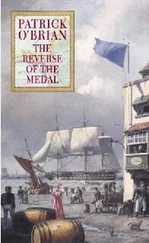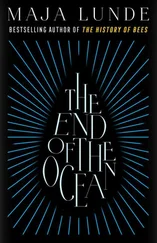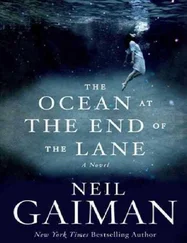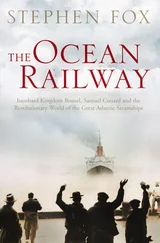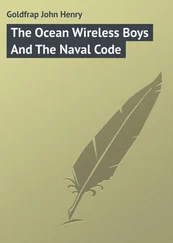“What’s that?”
“It was a reeducation camp. A labor prison. They put the prisoners to work building new neighborhoods for people the Revolution brought in from the campo. People said those new buildings had blood mixed into the cement and plaster.”
“What happened to him?”
“The family lost track of him. They didn’t try to visit him.”
“Why not?”
“That’s what the Revolution does. It ruins families. Parents and children each accusing the other of being traitors. Years went by. Maybe he died or was killed in prison. If he was released, we never knew it. When I came here I thought about looking for him. I like to think he got off the island when they let the prisoners onto the boatlifts. Maybe he was the lucky one and made it out before things got so much worse.”
I hear the woman at the agency explain to Nesto that he can get on the mula waiting list but if he doesn’t go when called, with as little as two days’ notice, he’ll lose his slot and have to go to the end of the line because there’s no shortage of people wanting to travel on the agency’s dime.
Nesto agrees to her terms, hands over his Cuban passport, and signs some forms.
There was a gringa I once knew from work who earned herself a Christmas bonus by flying to Cuba every December. She’d stop in Mexico City, where she’d be given a purse as heavy as a bowling ball and a ticket to Havana — all of it arranged and paid for by some unknown individual. There, she’d breeze through customs where everyone was paid off to let her through, meet a guy outside the airport where they’d give each other a pretend hug as if they were family. After a handoff of the bag and a night in the Habana Libre Hotel, she’d get on a flight back to Mexico the next day with the bag full of a different kind of weight to hand off to her contact in Mexico. She was warned never to look inside the bag, but one day she did and saw heavy bundles shrouded in black plastic. It was only after she stopped making those trips that another girl involved in the same smuggle told her what was in them: gold bars on the way into Cuba, and cocaine on the way out.
When he’s through with the final errand, Nesto and I walk back to his truck. I assume he’ll want to hang around Little Havana for a while, take in a little of the painted nostalgia, check out the shops on Flagler, or maybe get some Cuban food, but he doesn’t.
“Is there anyplace you want to stop before we head back down?”
I think for a moment. An unexpected urge comes over me.
“There is a place. Actually, there are two.”
That’s how we end up at the old house. Or what’s left of it.
I thought when the realtor told me the new owners planned to renovate and remodel, they’d at least leave the walls, but there is nothing left. No trace of the rooms where my brother and I once slept, the tiles I learned to walk on. Just the foundation, the grass pulled out all around it leaving a kind of moat. All that remains that is familiar to me is the cypress tree at the front of the yard, with roots that still seem to boil up from the earth, the tree my grandfather climbed with a shaky ladder to hang himself from one of its long branches.
I don’t want to get out of the truck. I don’t want any of the neighbors to see me, and I think if I keep my feet off the ground of the old block, it’s like I’m not really here at all.
Nesto leans over me from his spot in the driver’s seat to get a better look.
“So this is your house.”
“It was. Our house.”
I anticipated sadness at the sight of what became of the only home I remember living in before the cottage. Instead, I feel emptiness, as if the wind ruffling the tops of the palm trees could blow right through me, no flesh, no bones, no heart in its way.
Nesto senses it’s time to leave and starts the truck without my asking.
The house, and everything in it, is behind me now.
Gone.
* * *
And then we come to the bridge.
Nesto parks in the lot meant for fishermen and beachgoers on one of the flat ends of land joining the bases of the bridge. I remember the last time I came here with my mother. As I did then, I try to feel the footsteps on the concrete pathway, try to conjure a piece of my brother, and of my father, on the walk they each took to catapult a small life over the railing, sending so many other lives into the water with it.
I remember standing at the highest point of the bridge’s arc with my mother, half our family’s ashes in our hands. Two lives reduced to dust.
This time, I stand with Nesto.
He looks at me as if to ask if this is the place where it all happened and I nod.
The sea below us is a foggy green, dotted with a few small sailboats trailing each other. The bay stretches for miles, until the two strips of land lining it fade and the horizon becomes all water, the sun dipping toward it.
“Nesto, what do you think happens to us when we die?”
“I believe what the diloggún says. Life feeds on life. For every life that ends, a new one begins.”
“Do you believe in souls?”
“Yes.”
“Do you think they go somewhere else?”
“I do.”
“People say if there’s a heaven, Carlito wouldn’t have gotten in.”
“Nobody can know those things.”
He points straight ahead of us.
“You see that out there, where the sky meets the sea? When the world was made, there was no separation between heaven and earth. There on the horizon was the gate to heaven and it was wide open so humans could go into it whenever they wanted. These were the first generation of humans. They were still immortal. They didn’t yet know death. One day a man and a woman noticed that the animals were different from them. They couldn’t walk into heaven whenever they wanted but they could create life from their own bodies, and make babies. So the man and woman told Olofi they didn’t want to be divine anymore. They wanted to be like the animals and make life too. Olofi said if he gave them the power to make life from their flesh, their child would be of this earth, not carved by the hands of Obatalá or given the breath of life by Olódumare like they were. The child would have flaws and failures. It would be able to create life, too, but it would one day have to die. The man and woman wanted to have their own child more than anything so they agreed. Then Olofi broke the open path between heaven and earth so that humans could only cross into heaven in death.”
“You believe that?”
“I believe the message.”
“What is it?”
“We can’t be both human and divine. To be human is to be imperfect.”
When we were children, I was terrified of losing Carlito, even before I learned that he’d already almost been taken from us. After our mother went to bed, I would sneak into his room, and if he didn’t let me into his bed with him, I’d sleep on the floor beside it, to make sure that nothing happened to him in the night.
“Don’t worry, hermanita,” he would say. “I will never leave you in this world alone.”
As we got older and he grew reckless, drag racing his beat-up car on the empty roads of the Redlands he and his friends used as speedways, I would make him promise that if he died before me, he would give me signs to let me know his spirit was still with me even though our mother warned us it was mala suerte to talk about our own deaths.
When he was arrested, we stopped those types of conversations, and instead I forced myself to believe that my brother’s death would never come.
“There is something else the diloggún says,” Nesto tells me. “‘Death is but a journey into life, and life is but a journey into death.’”
He reaches for me. I think he’s going to hold me, but he just touches my arm and tells me to wait there, he’ll be right back.
Читать дальше
